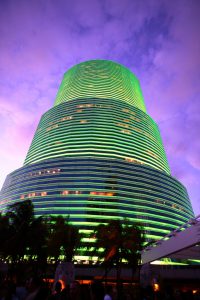MIAMI HERALD I Aug 2009 I Front Page
BY ELAINE WALKER
Brian Basti likes to get into an area before the crowds.
He was a pioneer in Miami’s edgy Park West neighborhood with nightclubs I/O Lounge and PS14. His other clubs helped put the Design District on Miami’s hip and trendy map.
Now he sees a similar opportunity in downtown Miami. That’s why he recently opened Ecco Pizzateca + Lounge. The two-story space starts the day as a restaurant catering to the business lunch crowd and then morphs into a late-night party lounge.

Basti is part of a new wave of entrepreneurs who see downtown Miami as an untapped market. The interest is motivated by a combination of the economy driving down rents and a growing marketof residents moving into downtown’s new high-rise condominiums.
“We’ve always thought downtown was missing something fun to do,” said Basti, who with his partners spent about $2 million on the new restaurant lounge at 168 SE First St. “It’s going to be a challenge, but we’re ready for it. We’ve always been able to draw our own crowds.”
Despite the recession and the real estate bust, 14 new businesses have opened in Miami’s Central Business District, the urban grid running north from the Miami River to Fifth Street. Of those, 12 are restaurants, ranging from fast-food fare to sit-down dining.
Some are cozy cafes with outdoor seating like Tré Italian Bistro. Others are over-the-top multimillion-dollar showplaces like Mia at Biscayne. There’s also Puntino, Mezza Mediterranean Grill, River Lounge and Giardino’s Gourmet Salads.
“Restaurants are what create the environment and the ambience that make an area unique,” said Boris Kozolchyk, senior vice president of retail with brokerage firm Grubb & Ellis, who has seen a moderate increase in restaurant tenants looking for space downtown. “After the restaurants the retail will follow.”
Attorney Cynthia Morales works downtown and welcomes dinner alternatives other than pizza delivered to her office.
“I can just walk over now and meet people,” said Morales, 34, who lives in the Brickell area. “It makes me feel like I live in a real city.”
While the changes are subtle, the new arrivals offer a sign of hope for an area that has been trying for the past few years to upgrade its downtrodden image.
“Even in the midst of a recession, a new neighborhood has been created,” said Neisen Kasdin, vice chairman of Miami’s Downtown Development Authority and, as a former Miami Beach mayor, a force for South Beach revitalization. “It’s becoming an exciting place for people to go. It’s the South Beach story all over again, just a little bit different version.”
The city and the Downtown Development Authority have been laying the groundwork for this renewal by investing millions in beautification projects, beefing up code enforcement and improving the police presence. The development authority also has given $650,000 in grants to help 28 property owners and businesses willing to upgrade.
But one of the critical pieces to turning around Miami’s urban core is creating a nightlife where everything doesn’t go dark after offices close at 5 p.m. Many of the new restaurants are staying open until 10 or 11 at night, while the new clubs like Ecco and Mia at Biscayne are open into the early-morning hours.
The demand for those later hours is increasing now that thousands of new residents are calling downtown Miami home. A study commissioned by the Downtown Development Authority found that even with the glut of condos, 62 percent of the units built downtown since 2003 are occupied.
Although many of those residents are renters, they still want places to eat.
“I don’t care if they are owners or renters; I just want bodies,” said Jose Goyanes, who opened Tré Italian Bistro on Flagler Street last month. He has seen the market firsthand at his other restaurant, La Loggia, and downtown Metro Beauty stores, all of which are enjoying sales increases despite the economy.
“Renters spend more than owners,” Goyanes said. “They have more disposable cash because they don’t have to pay association fees or insurance.”
Juan Chipoco, owner of Ceviche 105, has been amazed at the demand since he opened his Peruvian restaurant a year ago. The response has been so strong he’s already working on an expansion that will almost triple theseating in his restaurant.
Chipoco says he needs the additional seats because he’s drawing as many as 1,000 people a day on a Saturday or Sunday, including many coming from as far as Kendall and Weston.
“It’s unbelievable how fast the restaurant has grown,” Chipoco said. “I’ve never done any advertising. It’s all word of mouth.”
Shops, too, are seeing an improvement. A Macy’s executive said earlier this year that its Flagler Street store was seeing more growth in sales than the rest of the South Florida market.
It was Julie Greiner, former chairman and CEO of Macy’s Florida division, who took city leaders to task two years ago about the state of Flagler Street, threatening to pull the store from downtown.
Retailer Alberto Cortes has been in downtown for 42 years, but operated only from a second-floor location and catered largely to foreign tourists. The Cortes family believes so strongly in downtown’s rebirth that they invested $300,000 to expand and upgrade their store, creating a ground-floor presence on Flagler Street with the hope of attracting more local customers to buy their perfumes and cosmetics.
“When you’re on the second floor, you’re a well-kept secret,” said Claudia Cortes, who runs the business her father started with her sister. “We’re working on changing that.”
The new tenants are also helping to upgrade the mix in downtown, pushing out some of the luggage and electronics stores that catered to a less affluent clientele.
New York Bagel Deli is one of those upgrades. Scheduled to open in October on the ground floor of the Alfred I. DuPont building, the deli will take the place of an electronics store.
Owner Evan Steinman has had his eye on downtown for a few yearsas he was considering expanding beyond the Miami Beach restaurant he has operated for 14 years.
“I think the time is right to get in now before the city gets completely revitalized,” said Steinman, who is investing about $300,000 on the Flagler Street store. “You have to take chances in good times and bad times. A lot of companies started in the Depression.”
Don Vernon knows about taking chances in a developing area; he opened Uncle Sam’s music on South Beach in 1985, just when the area’s revitalization was getting started. Now, he is finalizing a deal to open a cupcake bakery and cafe in downtown Miami.
“It’s a new area like South Beach was,” said Vernon, who hopes to open his business for less than $200,000 and get a city grant to offset some of the costs. “I just see it as a place that has a lot of opportunity to grow. I like the feel of it. It’s got a lot of a grit.”
While Vernon is hoping to duplicate the success he had in South Beach, many retailers and restaurateurs in redeveloping areas aren’t so lucky. Often some of the early tenants aren’t the ones still standing when the area takes off.
“It’s very much about timing,” said Steven Hurwitz, senior vice president of Continental Real Estate Companies, who handles leasing for some downtown properties. “You want to be where you think the action is going to be, but not too early that you don’t have the staying power.”
PHOTO CAPTION: This is the next wave of investment in downtown Miami. Despite the bad economy and the issues with the condos entrepreneurs see the opportunity. New restaurants, shops and clubs have been opening and some existing are expanding. The newest location for New York Bagel Deli is opening soon at 155 East Flagler. Here, co-owners Evan Steinman, left, and Haim Yeffet at right look over the plans in front of their $50,000 bagel ovens. on August 27, 2009. AL DIAZ / THE MIAMI HERALD STAFF







 See More Blogs
See More Blogs
Comments